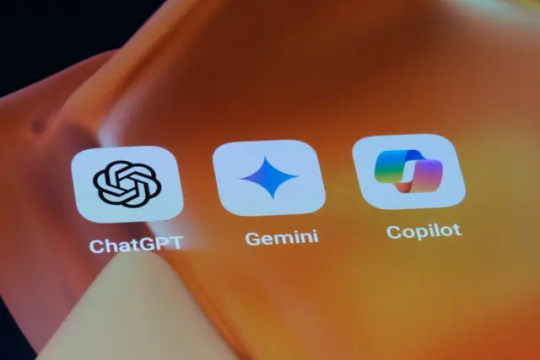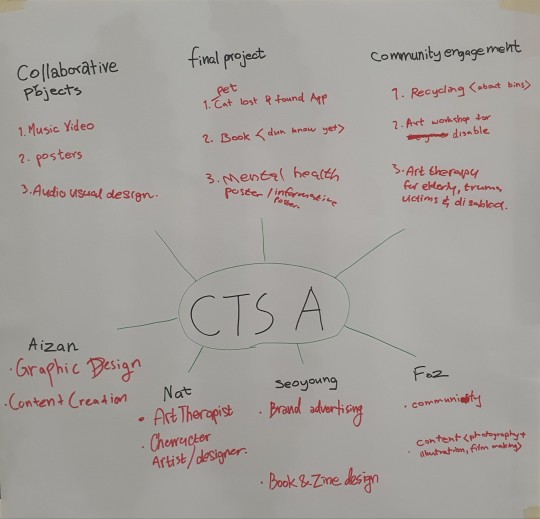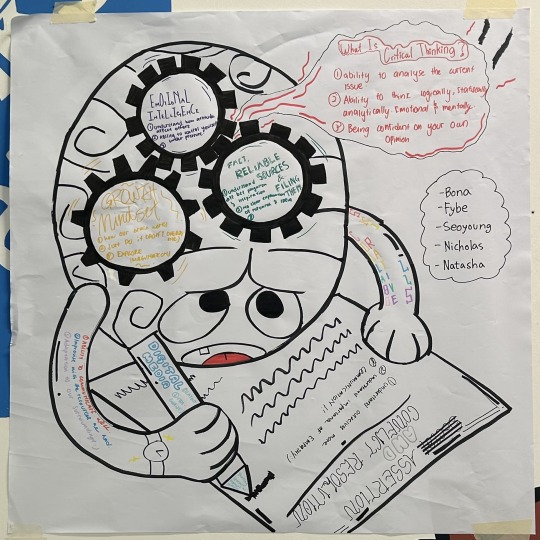#https://chatgpt.com/
Explore tagged Tumblr posts
Text
✨ 📖 ✏️ studyblr masterpost jam ✏️ 📖 ✨ Day #3 as an independent game designer maybe?
Today is the day for free resources, so here are mine 💞 the ones I used the most
first of all, chatGPT
I cannot stress enough how important is for us, people in technology, art and any creative field, to be friends with AI. They save us time, they explain things, they let us think, which is our best contribution to the world as human beings.
freeCodeCamp
It's a good place to start if you have no idea were to begin with, and they hold your hand through the path of tutorial hell, what is important to study and why is that so. They won't give you all the answers, but their courses make you think and learn by practice. Practice is everything here.
TheOdinProject
Same as freeCodeCamp, but for web development.
W3schools
To me, they have the best tutorials ever. I've stright copied their html css javascript examples in my early projects. Still do if I need to.
StackOverflow
They have an amazing community. Almost everything I asked is answered there, 3 years ago.
Honorable mentions goes to all the indian tech community that bless us all with their quality tutorials on youtube. Love you all.
#personal#diario#diary#blog#studyblr#codeblr#100 days of productivity#100dop#100 dias de productividad#100daysofproductivity#studyblrmasterpostjam#100 dop
8 notes
·
View notes
Text
Blackbox AI
versus ChatGPT and DeepSeek

A chat with Blackbox AI:
(Notes: "You" is me, Azeta AI. Typo: "us" should be "is".)







Blackbox AI
ChatGPT
DeepSeek
DeepSeek vs ChatGPT:
• BBC
• Tom's Guide
• Geeks for Geeks
• Zero DeepSeek
What is black box AI? – IBM
A transcript of a chat with OpenAI's ChatGPT 3 can be found here.
1 note
·
View note
Text
ChatGPT vs. Gemini vs. Copilot

The rise of AI chatbots has been fast, with more options becoming available to users. These bots are becoming a regular part of the software and devices we use every day.
Just like choosing an email provider or music app, you can now pick your favorite AI chatbot too. We’ve tested three of the most popular ones to help you decide which might be right for you.
Aside from these, there are others like Perplexity and Claude, but our focus here is on the biggest names: OpenAI's ChatGPT, Google's Gemini, and Microsoft’s Copilot.
We’ve tested each bot and included three standard challenges for evaluation. We asked for "a fun game idea for a 5-year-old’s birthday party," "a new smartphone app concept," and "instructions for resetting macOS."
In this blog, we're comparing the free versions of these chatbots available at the time of writing.
Which One Is Best for Regular Users? ChatGPT or Gemini or Copilot
ChatGPT powered by OpenAI
ChatGPT, developed by OpenAI, has been a leader in generative AI. It's widely accessible through web browsers on computers and mobile apps for Android and iOS. The platform has made headlines recently with announcements from OpenAI, including updates on their latest models and features.
There's a significant difference between the free and $20-per-month Plus versions of ChatGPT. The Plus version offers extra features like image generation and document scanning. Subscribers can also create their own GPTs with custom prompts and data. OpenAI's CEO, Sam Altman has mentioned that these enhancements are part of their strategy to democratize AI.
ChatGPT Plus provides access to the latest GPT-4 models, whereas the free GPT-3.5 is good for basic AI interactions. It's quick and versatile but lacks web link references like Copilot for fact-checking. The open AI search engine, one of the key initiatives, helps improve the platform's information processing capabilities.
Choosing ChatGPT is ideal for those interested in cutting-edge AI development. However, it's more effective with a paid subscription rather than on a budget. Apple's involvement with OpenAI has also fueled further interest in the platform.
In testing, ChatGPT performed reasonably well. It suggested a themed musical statues game for kids and a health-focused smartphone app named FitTrack.
Gemini powered by Google
Formerly known as Google Bard, Gemini is available as a web app and on Android and iOS. There are free and paid ($20 per month) plans.
Paying for Gemini gets you access to newer, smarter models. The interface resembles ChatGPT, and it integrates well with other Google services.
Gemini is suited for Google product users. It provided sensible responses to our challenges and suggested a neighborhood item-sharing app and a twist on the classic party game.
Copilot powered by Microsoft
Copilot is integrated into many Microsoft products like Bing and Windows. It’s available as a web app and mobile app.
Copilot uses Microsoft’s Bing search engine and often provides web links with citations. It's conversational and offers various text output settings.
The AI behind Copilot is OpenAI’s GPT-4, with different settings for text output: More Creative, More Balanced, and More Precise.
Copilot suggested "What’s the Time, Mr. Wolf?" for the kids' game and a virtual interior design app for smartphones. Its macOS reset instructions were accurate and cited from Apple’s support site.
If you use Microsoft products heavily, Copilot is a natural choice. It excels at referencing web information and providing clear citations.
In conclusion, all three—ChatGPT, Gemini, and Copilot —can be used for free, allowing you to choose based on your preferences. Copilot offers the most AI features without payment, ChatGPT is highly competent with a subscription, and Gemini is ideal for Google fans.
Frequently Asked Questions (FAQs)
How Do Chatbots Understand Language Differently Than a Programming Language?
Chatbots and programming languages are different in how they understand language.
Programming languages like Python or Java are structured and strict. They need exact commands and follow clear rules to work. If you make a mistake, the program won't function correctly.
Chatbots, on the other hand, are designed to interpret human language. They use techniques like Natural Language Processing (NLP) to understand words, phrases, and even context. This allows them to grasp the meaning behind what people say, even if the words are not in a set pattern.
A chatbot can recognize synonyms (different words with similar meanings), understand the intent behind a sentence, and learn from the interactions it has with users. This flexibility is what sets chatbots apart from programming languages, which rely on strict instructions to perform tasks.
What Does the Generative AI Ecosystem Refer to?
The term "generative AI ecosystem" refers to a network of technologies, tools, and methodologies that use artificial intelligence (AI) to create or generate content autonomously. This ecosystem encompasses various AI models and algorithms designed to produce new and unique outputs based on learned patterns and data.
In simpler terms, generative AI involves systems that can generate things like text, images, music, or even video without direct human input for each specific output. These systems learn from large datasets and then use that knowledge to create new content that resembles what they've been trained on.
This ecosystem includes a range of technologies such as language models (like GPT), image generators (like DALL-E), and music composers that are able to produce content that is novel and, in many cases, convincingly human-like. The ultimate goal of the generative AI ecosystem is to automate and enhance creative processes across various domains, potentially transforming how we create and interact with digital content.
2 notes
·
View notes
Text
*Creative and Avant-garde RPG* In this game, players create and then play a tabletop RPG. To play:
Go to https://chatgpt.com/ and send the following message:
“You are a creative and avant-garde designer of tabletop RPGs. Create the rules of a tabletop RPG that can be played in 2-3 hours. You should start by deciding on a topic and some themes you want to explore. Then, create mechanics and a procedure that reinforces the topic and themes.
Since you will be creating a new game without an established culture of play, try to let the procedures speak for themselves without assuming the players will know what to do.
Include all materials necessary to play including rules, procedures, character sheets, etc.”
Play the game described. --- Permission is granted to repost anywhere. I release this game to the public domain.
200 Word RPGs 2024
Each November, some people try to write a novel. Others would prefer to do as little writing as possible. For those who wish to challenge their ability to not write, we offer this alternative: producing a complete, playable roleplaying game in two hundred words or fewer.
This is the submission thread for the 2024 event, running from November 1st, 2024 through November 30th, 2024. Submission guidelines can be found in this blog's pinned post, here.
14K notes
·
View notes
Video
youtube
سلام تو این ویدیو میبینیم که چطوری یه انیمیشن رو بصورت کامل با هوش مصنوعی های مختلف بسازیم و خیلی راحت ایده ی خودمان را تبدیل به یه انیمیشن یا کارتون بکنیم. در پایین ابزارها و سایت های استفاده شده رو میزارم
به کانال تلگرامی آواسام جوین شوید https://t.me/avasam_edu سایت ما : https://avasam.ir
ابزارها و سایت های استفاده شده https://chatgpt.com/ https://ltx.studio/ https://hailuoai.video/ https://ivira.ai/ https://pixabay.com/
--- موضوعات ویدیو : 00:00 شروع 01:11 ایده پردازی انیمیشن با هوش مصنوعی 05:35 پیاده سازی شخصیت ها 10:41 تبدیل شخصیت ها به ویدیو زنده 15:46 هوش مصنوعی تبدیل متن به صوت 23:00 نتیجه نهایی
0 notes
Photo

An image showcasing the concept of dark silver with a metallic texture. It features a sleek and reflective surface that highlights the depth and richness of the color. Made with -> https://chatgpt.com/
0 notes
Text
Blog Post 32: Final Project 2: Week 5 Progression
This blog focuses on the progress made during the fifth week of development for the secondary project, titled “Frost Generator.” In this blog, we will discuss the final level design and the ideas behind the development of the final level.

The initial goal for this week was to establish the foundation for the final level design and create the blueprint upon which the final level would be structured. After days of hard work, I am extremely pleased to share that not only was I able to achieve the first goal, but I also managed to complete the initial steps in plotting the level in Unreal Engine, despite the obvious difficulties in exporting assets from Blender to Unreal.
Progress
Initial Level Layout
After completing the texturing process of the generator, including the newly redesigned outer structure of the upper section, I set upon the task of laying down the blueprint for the final level in Blender using props.

After finalizing the first impression for the level, I then used ChatGPT to generate a sample image for a level filled with pipes. While not an ideal result, the image still provided sufficient visualization of what this level would eventually look like.

Creating Modular Walls and Flooring
An interesting and fun progress made this week was the creation of unique wall assets, each designed in a modular form to be used effectively in multiple positions within the environment. Two distinct wall pieces were created, which were used in combination to form both the walls and the floor of the environment in Unreal.



Exporting Assets to Unreal
The task that took the maximum effort and time this week was the process of exporting all the individual assets from Blender to Unreal. With a combined total of 50+ assets, each with its own accompanying texture sets that needed to be individually connected to Unreal texture nodes, the process took more than two complete days of non-stop work to accomplish.

Developing and Redesigning Assets
Finally, the internal pipe layout of the generator was redesigned to achieve the level of practicality and realism that I have set as a goal for this project. Furthermore, connectors were modeled to soundly link the temperature gauge to the body of the generator.



Problems Faced
Export Process from Blender to Unreal
The primary cause of concern was the entire export process from Blender to Unreal. Unlike other 3D modeling software, such as Maya, which has direct export options that enable entire sets of assets to be seamlessly exported to Unreal, Blender requires a more manual approach.
The process involves exporting the assets as FBX files, with texture files being exported and stored separately from Adobe Substance Painter.

These assets are then imported into Unreal, where each asset must be reassigned their textures one by one. This is not before setting every texture map to its intended “masking” category.

The entire texture assignment process requires a user to manually link each texture map to its respective node, one by one.

The process was a working nightmare, making me question my decision of choosing Blender as my primary 3D modeling tool.
youtube
Final Thoughts
This week’s progress was a paradox. On the one hand, it was incredibly productive, achieving every goal set out at the beginning. On the other hand, it felt like the slowest and most redundant due to the tedious export process. Regardless, this week has been a valuable learning experience, especially in understanding the challenges of exporting from different 3D modeling software to game engines. The knowledge gained will undoubtedly help streamline future workflows.








Goals for Next Week
Finalize the level layout
Populate the scene with all assets
Create additional assets if required
RESOURCES USED:
OPENAI (2024). ChatGPT. [online] chatgpt.com. Available at: https://chatgpt.com.
Matt Aspland (2024). How To Properly Export From Blender To Unreal Without Losing Textures. [online] Available at: https://www.youtube.com/watch?v=HIzDW4FlC-U [Accessed 5 Dec. 2024].
SKILLS LEARNED
Exporting Assets to Game Engines
SKILLS TO LEARN
Lighting
VFX
Post Processing
0 notes
Text
CTS A | WK10 Summative Assessment Prep — Session 1
In today's class, we worked in teams to create a mind map using a visual metaphor for the topics we've covered over the past seven weeks. After coming up with a variety of ideas, I suggested a jellyfish and the rest of the team agreed, so we chose it as our visual metaphor. On the head of the jellyfish, we wrote each of the class topics we've covered, and on the legs, we wrote three key points about each topic based on the knowledge and insights we've gained from the class. We chose the jellyfish because we felt that its symbolism of flexibility and adaptability fit well with the process of learning and growing from new ideas in our CTS classes. Just as the jellyfish moves with the current, our group wanted to capture our desire to be open-minded and flexible as we explore new topics that come up in the future.

One of the main benefits of visualizing what we've learned over the past seven weeks is that we've been able to organize the complex ideas of each week into something that is easier to understand at a glance. Visualizing made it easier for me to see patterns and connections and deepened my understanding of each topic. I also think it helped me a lot in terms of reinforcing learning during the creation process and recalling previous activities.
Teamwork also played a very important role in this project, as we were able to work together and share our perspectives and insights, which enriched the final product. Everyone in the group had different ways of thinking about the topic and key points, and I think this diversity of ideas helped a lot in creating the overall mind map. The process of organizing ideas visually was an invaluable experience for creativity and for reflecting on the lesson.

(306 words)
Reference resources :
In my submission I acknowledge the use of :
GenAI : https://chatgpt.com/
Use : The sentence I wrote turned into an image.
Prompt : Translate to Korean.
Use of Prompt : I needed an intuitive image that showed the freedom of the jellyfish and the flexibility that a designer should have, so I included this image to help me imagine what I was writing about.
0 notes
Text
CTS A | week 12_ Summative Assessment Prep — Session 3
For my final project, I would like to design recycling bin packaging environmental issues. In Singapore, It is hard to find detailed recycling bins with separate categories like general waste, plastics, plastic bags, paper, food waste, etc.

“Recycling Bin Stock Photos, Illustrations and Vector Art | Depositphotos.” Depositphotos, depositphotos.com/photos/recycling-bin.html?filter=all&qview=180449132.
Introducing more this system in Singapore could be beneficial. And I could contribute to the "Ministry of Sustainability and the Environment Singapore." having a vision of "clean and sustainable Singapore,". I have three proposed projects for collaboration:
1. Website Redesign: I could propose a new web design for their official website to improve user experience and engagement.
2. Social Media Campaign: They currently suggest "10 easy ways to reduce waste as an individual" on their website. I can design social media promotional posts based on these 10 methods to spread awareness.
3. Reusable Water Bottle Design: Among the "10 easy ways to reduce waste as an individual," there is a recommendation to "Don't leave the house without a full reusable water bottle." I could design a tumbler and develop a project where a portion of the sales is donated to environmental causes, or the tumbler could be included in packages given as part of a donation campaign.

Ministry of Sustainability and the Environment, Singapore. “Ministry of Sustainability and the Environment, Singapore | LinkedIn.” Ministry of Sustainability and the Environment, Singapore, sg.linkedin.com/company/ministry-of-the-environment-&-water-resources.

For Individuals. www.mse.gov.sg/take-action/individuals.
Additionally, there is an idea to collaborate with Lasalle Diploma in Audio Production students to create an advertisement video for '10 easy ways to reduce waste as an individual.' They will create the advertisement music, and we will edit the video.
I am interested in brand advertising and digital marketing after graduation. Brand advertising focuses on shaping brand image, and digital marketing promotes products online for sale. Both require strong analytical skills using critical thinking. For instance, when a marketing strategy fails, critical thinking helps identify why it didn't work, asking specific questions like 'What kind of customer didn't or did respond, and why? Was the issue with the message or ad frequency?' This analysis refines strategies. CTS skills also help evaluate competitors' strengths and weaknesses, providing a clear, objective view to differentiate our approach.

(329 words)
In my submission I acknowledge the use of:
GenAI: https://chatgpt.com/
Use: To define 'Brand advertising' and 'Digital marketing'
Prompt:
Use of Prompt: I modified the information to use in the introduction to my essay.
2. GenAI: https://chatgpt.com/
Use: Translate naturally in English
Prompt: "Could you translate 'where a portion of the sales is donated to environmental causes or the tumbler could be included in packages given as part of a donation campaign.' in English?"
Use of Prompt: I used the following sentence "where a portion of the sales is donated to environmental causes, or the tumbler could be included in packages given as part of a donation campaign.".
0 notes
Text
Hà My, một nhân viên marketing trẻ tuổi vừa nhận công việc tại một công ty startup chuyên về thực phẩm hữu cơ. Một ngày nọ, cô được sếp giao nhiệm vụ tìm một dịch vụ thu âm quảng cáo chuyên nghiệp để thực hiện chiến dịch marketing trên mạng xã hội. Với niềm háo hức của người mới vào nghề, Hà My bắt đầu tìm kiếm trên Google và Chatgpt
Cô lướt qua hàng loạt trang web trên Google, diễn đàn và cuối cùng quyết định chọn một đơn vị có giá rẻ hơn so với mặt bằng chung. Họ cam kết “chất lượng tốt, giá rẻ, thời gian hoàn thành nhanh chóng”. Nghe có vẻ hấp dẫn, Hà My ngay lập tức liên hệ và gửi kịch bản đọc quảng cáo để họ thực hiện.
0 notes
Text
tabs I have open right now:
Tumblr x3
Novelty
Online Games
Poki
My book
Character Sheet of Doom (my book character sheet)
Quotev
ChatGPT
Youtube (annamarie)
lechon recipes google search
1 note
·
View note
Text
Land For Sale in Meath
Looking for land for sale in Meath, Ireland? Whether you're interested in building your dream home, starting a farming project, or making a strategic investment, Meath offers a variety of land options. With its rich history, scenic countryside, and proximity to Dublin, Meath is a sought-after location for buyers.
Before purchasing, it’s important to research zoning laws, land use restrictions, and access to utilities. Meath's mix of rural and semi-rural properties can offer everything from smaller plots to expansive estates. If you're new to buying land, consider consulting a local real estate agent or solicitor to help navigate the process.
The county is growing in popularity due to its blend of rural charm and easy access to the capital, making it ideal for long-term investments. Keep an eye on local listings, and you might just find the perfect plot for your next project! Read more - https://keenanauctioneers.com/
#LandForSale #Meath #PropertyIreland
0 notes
Text
CTS A | Week 10 Compulsory Question 1

In class, our group discussed the brain metaphor; however, I independently conceived the idea of a city with bridge. I stated that critical thinking is the foundation of effective analysis, with strong pillars that symbolize the ability to think logically, statistically, and analytically. Collaborative skills, such as effective communication and adaptability in collective projects like monument construction, are necessary for inquiry. Additionally, engaging with peers during this exercise demonstrated the importance of teamwork. We were able to help one another in ways that led to new ideas through efficient communication, resource improvisation, and environmental adaptation.
Emotional intelligence is about managing your emotions under pressure and understanding how your emotions affect others. This is especially important when working in groups. Argumentation and conflict resolution are symbolized by the observation tower, which emphasizes the importance of empathy and self-awareness in approaching problems from multiple perspectives. The railing symbolizes a growth mindset, motivating people to face challenges and realize that results can differ, fostering exploration without getting stuck on details. One enjoyable part of this experience for me was the session on growth mindset. I typically find it hard to draw and sketch under pressure, but this session provided an enlightening new way to look at it. Using my unusual hand for drawing sparked new ideas and a refreshing sense of curiosity that I really enjoyed.
Next, the surrounding landscape signifies the importance of facts and reliable sources, underscoring the need to differentiate between plagiarism and inspiration within ethical research practices. Finally, the act of crossing the bridge symbolizes the application of digital media in documenting and sharing artistic work, effectively bridging the gap between practice and presentation.

I wish my English had been better so I could have used a larger vocabulary to explain my work and better express my ideas. Improving my language abilities would have made the process even more fulfilling by enhancing my contributions to group discussions and the overall experience.
(321 words)
Photo (Improving language skills enhances our ability to communicate ideas clearly, making group discussions and experiences more fulfilling.)
reference resources::
“Hotel near Tower Bridge: The Tower Hotel.” Thistle The Tower, www.thistle.com/the-tower. Accessed 4 Nov. 2024.
“Pin by Maria Cecilia on Guardado Rápido in 2024: Career Vision Board, Business Women, Career Girl.” Pinterest, 20 May 2024, www.pinterest.com/pin/492649952869374/.
In my submission I acknowledge the use of:
GenAI : https://chatgpt.com/
Use: To translate my sentences fluently into English
Prompt: Translate this in korean.
Use of Prompt “ Collaborative skills are essential for inquiry, showcasing effective communication and adaptability in joint projects like monument construction. Additionally, engaging with peers during this task demonstrated the importance of collaboration.”
0 notes
Text
ChatGPT Successfully Diagnoses Rare Condition After Three Years of Medical Misdiagnoses

The protagonist of this remarkable story is a 4-year-old boy named Alex. According to his mother, Courtney, Alex began experiencing unexplained pain in 2020, requiring daily painkillers to alleviate his symptoms. After three years of fruitless medical visits, a surprising breakthrough came when ChatGPT successfully identified Alex’s condition, leading to the correct treatment and recovery.
A Long Journey of Misdiagnoses
Initially, Alex’s parents suspected his pain was linked to teething or cavities, as he also exhibited teeth grinding at the time. They took him to a dentist, but the dentist ruled out dental issues and instead suggested airway obstruction as a possible cause due to its impact on sleep, which could lead to fatigue and irritability. The dentist referred them to an orthodontist specializing in airway issues.
The orthodontist found that Alex’s upper jaw was too small, causing difficulty in breathing at night. Alex was fitted with a palate expander, which provided temporary relief, but the symptoms soon returned.
New Symptoms Emerge
Courtney noticed Alex had stopped growing and observed an imbalance in his leg development. He would often lead with his right foot while dragging his left leg. Concerned, she took him to a pediatrician, who attributed the symptoms to COVID-19 complications and recommended physical therapy to address the leg imbalance.
However, physical therapy proved ineffective, and Alex began suffering from severe headaches. A visit to a neurologist resulted in a diagnosis of migraines, but the treatment did not resolve his condition. Fatigue persisted, prompting another visit to an ENT specialist to rule out sleep apnea or sinus issues.
Eventually, a physical therapist suggested that Alex might have Chiari malformation, a congenital condition where brain tissue extends into the spinal canal. This gave Courtney a lead, and she began researching the condition herself, consulting multiple specialists, including pediatricians, internists, and musculoskeletal doctors. However, none of them could provide a definitive answer.
Turning to ChatGPT
Frustrated and desperate, Courtney decided to try ChatGPT, hoping the AI could offer some useful insights. She meticulously entered Alex’s symptoms, medical reports, and history into the chatbot. To her surprise, ChatGPT suggested a diagnosis of Tethered Cord Syndrome (TCS).
What Is Tethered Cord Syndrome?
Tethered Cord Syndrome is a rare neurological disorder with an incidence rate of about 0.005–0.025% in newborns. According to the U.S. National Institute of Neurological Disorders and Stroke, this condition occurs when the spinal cord becomes abnormally “tethered” or attached, restricting its movement within the spinal column. This tethering can place undue stress on the spinal cord during growth or movement, leading to nerve damage and dysfunction.
Symptoms of TCS include:
Leg pain
Abnormal gait
Spinal deformities (e.g., scoliosis)
Muscle weakness
Foot abnormalities
Many of Alex’s symptoms aligned with TCS, prompting Courtney to pursue this lead further.
The Correct Diagnosis and Treatment
Armed with ChatGPT’s suggestion, Courtney consulted a neurosurgeon, who confirmed the diagnosis of Tethered Cord Syndrome. The surgeon was able to pinpoint the exact location of the problem and immediately scheduled surgery.
Following the procedure, Alex’s symptoms improved significantly, and he finally regained his smile after years of pain and discomfort.
A Testament to AI in Medicine
This incredible story highlights the potential of AI tools like ChatGPT in assisting medical diagnoses, especially for rare and complex conditions. While AI cannot replace doctors, it can serve as a valuable resource for patients seeking clarity and direction in their healthcare journey. For Alex and his family, ChatGPT became an unexpected hero, offering a beacon of hope when all else had failed.
0 notes
Text
Blog Post 29: Final Project 2: Week 4 Progression

As I sit down to write this blog, I am amazed by the sheer amount of progress I was able to make in the span of one week. From texturing the basic structure of the generator to redesigning several components built to fulfill the fundamental aim of this project—creating artistic yet realistic assets. Practicality over design has been the motto I adhered to for this project, and I am extremely glad to have achieved it to a great extent.
PROGRESS:
Complete the Initial Texture Process of the Generator
One of the key components that I have only recently realized I failed to mention in earlier blogs is the UV unwrapping process in Blender. This process is not only the most difficult in terms of technicality but also the most significant in terms of results, as it directly impacts the final texture of the project.

I diligently worked on creating symmetrical UVs that would allow for the best-looking final product while teaching me techniques for future use.

The overall texture of the generator adhered to the dark iron, copper, and brass materials used in the exterior pipes. However, a slight difference was made in the grainy texture of the pipes themselves, as it would make sense for these crucial pipes to be more refined and polished compared to others.


Re-Imagining the Temperature Gauge
While the original temperature gauge was not impractical, it still lacked the artistic and aesthetic connection to the overall structure of the generator’s body.

After thorough consideration, I decided to create a new temperature gauge that would not only fit into the steampunk aesthetic but also serve a more practical purpose of displaying sensitive temperature data.


Practicality and Realism
A strict focus on practicality and realism became the focal point for the creation of new assets as well as the redesign of old ones. Here are a few examples:
Ladder Design: The ladders were modeled after northern Russian ladders, featuring wooden handles to better insulate against the cold temperatures.


Walkway Texture: The walkways on the generator’s outer edges were textured with dirt and mud to reflect frequent use by workers.

Furnace Handles: The furnace door handles were redesigned with a steel frame and wooden handles for insulation against the furnace heat. Additional details such as char and coal smudges were carefully added for realism.

Additional changes included a properly connected gauge, redesigned railings, updated pipe layouts, and added handles on either side of the furnace section of the generator.
Problems Faced
Boolean Cutting and Internal Faces
An unexpected problem arose while creating square windows in the upper section of the generator. Using Blender’s Boolean cutting method resulted in unexpected edges and vertices. This caused significant issues during subdivision, producing “N-gon” faces, which disrupted shading and texturing.

The problem was resolved by manually creating edges and connecting the disconnected vertices by hand. Though tedious, this solution proved effective.
UV Unwrapping
UV unwrapping continued to be a challenge throughout the project. Several objects required an extremely delicate and time-consuming UV breakdown process, which then had to be assembled by hand into a symmetrical form for proper texturing.

Final Thoughts:
This week’s progress has not only brought the project closer to completion but has also provided valuable lessons in texturing, UV unwrapping, and balancing aesthetics with realism. With these advancements, I’m excited to tackle the remaining tasks in the coming weeks.
Goals for Next Week
Finalize the texture process of the generator
Build the blueprint for the final level layout
Start exporting all assets to Unreal
RESOURCES USED:
OPENAI (2024). ChatGPT. [online] chatgpt.com. Available at: https://chatgpt.com.
eBay. (2024). Stainless Steel Foldable Boarding Ladder 4 Wooden Steps Boat Folding LADTRANSWD4. [online] Available at: https://www.ebay.co.uk/itm/302537835402 [Accessed 25 Nov. 2024].
SKILLS LEARNED
UV Unwrapping
Fast modelling
Realistic texturing
Practical modelling
SKILLS TO LEARN
Exporting assets from Blender to Unreal
Better UV Unwrapping
Creating better models.
0 notes
